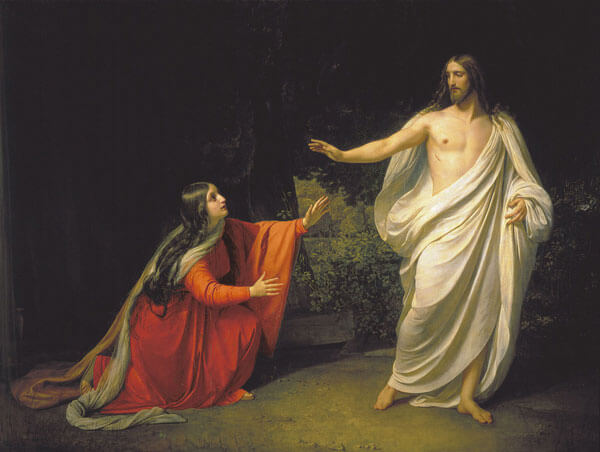

“The Appearance of Christ to Mary Magdalene” by Alexander Ivanov (oil on canvas, c. 1835, Russian Museum St. Petersburg)
Adamo has clearly done his research, and all of the controversial claims made by his libretto (that Mary Magdalene was not only a trusted disciple and wife to Jesus, but also dramatically shaped his teachings) are backed up by footnotes, several of which were sung (as though Adamo felt the need to point out that he wasn’t making it all up). The supertitles reflected this by putting the sung citations in parentheses.
The heterogeneous audience at the Saturday performance was composed primarily of the standard older operas patrons and season-ticket holders. We lost mass (pardon the pun) when many people left after intermission. Overall, the audience was neither too cold nor too receptive. Applause was polite, but not more. I overheard mixed comments during intermission, ranging from acidic critiques of every aspect of the production (and the music) through high praise of the individual singers, especially Sasha Cooke, who sang a brilliant Mary Magdalene. The rest of the cast, including several of this year’s Adler Fellows, sang well. I particularly enjoyed Maria Kanyova’s portrayal of Miriam (Mary, the usual one).

Mezzo-soprano Sasha Cooke as Mary Magdalene and baritone Nathan Gunn as Yeshua (photo credit: San Francisco Opera)
Michael Christie made his San Francisco Opera debut as conductor of the opera orchestra. The orchestra functioned primarily as aural backdrop, with occasional harsh dramatic interjections. It almost sounded like film music, providing support to the cast and setting the mood for dramatic action. Unfortunately, the large orchestra so overwhelmed the even larger cast of un-amplified singers that there were many points at which one couldn’t hear what was being sung at all. Many modern operas either use some form of amplification or use a reduced (or even chamber-sized) orchestra for accompaniment in order to minimize exactly this issue.
Constance Hoffman meticulously researched and designed the consumes for this production. Except for one disciple who was wearing a fabric that looked a little bit like first century BCE tie-dye, they were mostly of dull, earthen colors. The costumes blended well with the set, which remained the site of an archeological dig for the entire production. Colored lighting was used at times to change the mood (if not the actual shape) of the set, and spot lights were used to create halos and auras at key moments in the drama.
Overall, the production felt clichéd, as though the opera stumbled from one over-used motive to the next. While Adamo’s ideas are fascinating, the score stops short of adequately expressing the controversy and brilliance of what might have been a fantastic opera. While the libretto is mostly a saving grace, one line comes to mind in summary: “As God, I guess, intends.” It seems that much like his very human characters, Adamo isn’t entirely sure where the music is going.
